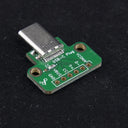USB Type-C Plug Breakout - USB 2.0
by Solder Party



This plug and breakout board provides an easy way to extract signals and power when plugged into a USB Type-C Receptacle.
By default, the CC pin is connected via a 5.1K resistor to GND (-), meaning the plug identifies as a downstream port, and the upstream port will provide up to 1.5A at 5V. You can replace or move the resistor to pull the CC pin to VBUS (+) or change the pull value.
The 2.0 variant of the breakout board skips the SuperSpeed pins; they are left floating.
As per the USB Type-C specification, the plug has only one pair of D+/D- pins; it’s up to the Receptacle this is plugged into to connect them together or use a mux for more advanced scenarios. Similar with CC and VCONN pins.
For more details about USB Type-C, check out this application note or the USB Type-C Specification.
Downloads
Datasheets
CAD Files
Hardware Files
- You can find KiCad hardware source files for the boards on Github.
License Information
The USB Type-C Plug Breakout hardware designs are licensed under the CERN Open Hardware Licence.
This documentation is licensed under the Creative Commons Attribution-ShareAlike License.
-
USB Type-C Plug Breakout - USB 2.0
SP00624% off!£1.90was £2.50
Shop with confidence – we've been serving the hobbyist electronics, Maker, and retro gaming communities since 2012.
- Satisfaction or refund guarantee
- Worldwide shipping via mail or courier
- 57,000+ customer reviews
- Secure website and payments
